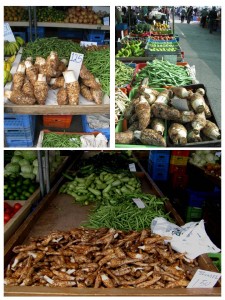 I was reminded during a recent trip back to Cyprus (my first visit in 20 years after living there for quite a while) of the curious fact that taro is a staple of traditional Cypriot cuisine, something of an outlier in the Mediterranean. Called kolokassi, the tuber is prepared in a number of ways, and the young offshoots, or suckers, are also taken fried. You can see these in the photo, labelled “poulles.”. Peter J. Matthews has this to say in his “Genetic Diversity in Taro, and the Preservation of Culinary Knowledge“:
I was reminded during a recent trip back to Cyprus (my first visit in 20 years after living there for quite a while) of the curious fact that taro is a staple of traditional Cypriot cuisine, something of an outlier in the Mediterranean. Called kolokassi, the tuber is prepared in a number of ways, and the young offshoots, or suckers, are also taken fried. You can see these in the photo, labelled “poulles.”. Peter J. Matthews has this to say in his “Genetic Diversity in Taro, and the Preservation of Culinary Knowledge“:
In Cyprus only one cultivar of taro is grown, but there are at least nine distinct ways of preparing taro (skhara, vrasto, souppa skourdalia, tiganites, kappamas, yiakhni, psito, moussakas, Matthews 1998a) (Figure 4). The fermentation of taro starch, and the edibility of leaves (petioles and blades) are not known in Cyprus. All the methods recorded use heat to reduce acridity — by simmering, boiling, stewing, frying, roasting, grilling, and baking (steaming was not reported). For each named dish, the details of preparation varied from person to person and village to village. The range of dishes is not large, compared to the range in Japan (Matthews 1995), but does involve a greater range of methods for applying heat.
You can find out more in the book “The Global Diversity of Taro: Ethnobotany and Conservation,” in which Dr Matthews has also had a hand. Poulles are not mentioned, which makes me think their consumption may be a relatively recent innovation.
It’s not clear where that one Cypriot cultivar may have come from, though Matthews says that the crop “is likely to have reached Cyprus in ancient times from India or Africa, via the Levant or Egypt.” That makes sense, but will be difficult to verify, as there is precious little in the way of germplasm collections in the region between Europe and India. I would imagine Egypt in particular would be fertile territory for a bit of collecting. I wasn’t able to find any ancient Egyptians representations of the plant, but I wouldn’t be surprised if they exist.
Luigi,
Your’e right, Egypt would be a great place for collecting taro germplasm and traditional knowledge. There are ancient accounts from pre-Ptolemaic Egypt of annual hippopotamus hunts in the lower Nile organised by the Phaeroes and their administrators in which the rich meat was cooked with Colocasia. This is something that Peter Matthews has documented. My own ethnobotanic historical research in Lisbon (back in the day) at the then Instituto de Pesquisas do Ultramar cited reports from early Portuguese explorers in West Africa, that this root crop Colocasia was already present in Sao Tome e Principe and in the Dahomey, Gold Coast and Kongo kingdoms. Taro is an ancient global crop in the tropics and we are glad to see the growing interest in this species. Thanks for the Taro shout out.
“Smithsonian says The taste of Indonesia is salak, a name I didn’t recognise even when told it is snakefruit. Or Salacca zalacca, a name to really conjure with.”
Or rattan fruits by another name, which explain the “snake” part – because the plant snakes up into the canopy of the rainforest. Southern Thailand, Malaysia and Indonesia all enjoy numerous species of this fruit, fermented and fresh, as a treat.
Thanks Penny. I think you meant to post this as a comment to the Nibbles that mentioned it. I’ll move it over.
So, does Salacca zalacca grow in Malacca?